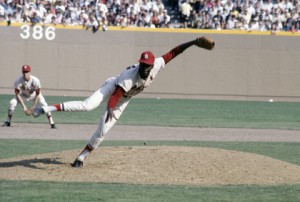Being a Staff Ace Isn’t What it Used To Be

Despite being the staff ace, there was never any thought by the Rangers of having Cliff Lee pitch three games in the World Series.
If I was writing this column in 1970 or even in 1990, it would be about Cliff Lee’s preparation to start game four of the World Series for a Texas Rangers squad that trails two games to one and desperately needs a strong performance from their best pitcher.
However, because we are in the year 2010 when pitchers are often treated like fine china, this column is about how the Rangers must figure out how to win three more games though their staff ace will pitch just one more time in the series.
What is interesting about the decision by Ron Washington to pitch Tommy Hunter in game four, instead of to start Cliff Lee on three day’s rest, is that it really isn’t a decision at all. I every interview from prior to the World Series through game three, Washington never wavered in his insistence that Lee would not pitch a day earlier than normal regardless of the situation in the Series.
Given that Lee struggled in the first game with a week of rest, it makes sense not to take a chance bringing him back early. However, the decision means that should the Series come down to one final game, the Rangers would not be pitching their staff ace.
Of course the same would be true for the San Francisco Giants, but even with consecutive Cy Young Awards to his credit, there has never been discussion about maneuvering their rotation to get a third start out of Tim Lincecum.
What is interesting about the situation for the Rangers is that just a year ago, Lee and his previous team the Philadelphia Phillies were in the same exact situation.
Trailing two games to one against the Yankees, Philadelphia manager Charlie Manuel did not start Lee in game four though the Yankees were pitching their ace C.C. Sabathia on short rest. The Yankees went on to win the game and take a 3-1 Series lead. Lee won game five, but the Yankees claimed the Series in six games.
Prior to Sabathia a year ago, the last pitcher to start both games one and four in a World Series was Curt Schilling for the Arizona Diamondbacks in 2001. In fact, Schilling started games one, four and seven and pitched into the eighth inning in all three games as the Diamondbacks won the Series over the Yankees.
In the era before five-man pitching rotations became standard, it was common for teams to regularly go with three-man rotations in the playoffs to ensure that their ace could pitch three times in a seven game series.
In the 1991 World Series, Jack Morris of the Minnesota Twins pitched games 1, 4 and 7 to lead Minnesota to victory. In game seven, he pitched 10 scoreless innings to earn the victory. His fellow starter on that night was John Smoltz of the Braves, who had not pitched in the Series until game four, but pitched seven scoreless innings in game seven also on three days rest after having battled Morris in game four.
The Twins were the beneficiary of another three-game starter in 1987 when Frank Viola won games one and seven, but lost game four.
Having an ace pitch three times in a Series has never been a guarantee of victory in every game, but over history has typically given teams a chance to keep their other pitchers available for relief while ensuring their best pitcher was getting maximum chances.
That seemed to be the case for the Cardinals in 1985 when staff ace John Tudor allowed only one run in 15.2 innings in winning games one and four.
With him on the mound in game seven, many expected the Cardinals to cruise past the Kansas City Royals. However, just four days after shutting out the Royals in a 3-0 shutout victory, Tudor allowed five runs before being knocked out in the third inning. It was Bret Saberhagen, who had started game three for the Royals and was pitching on regular rest, that was the pitching star of the finale.
Nearly two decades earlier, the Cardinals used the same strategy in consecutive World Series with slightly different outcomes. In 1967, Bob Gibson pitched complete game victories in games 1, 4 and seven to lift the Cardinals past the Boston Red Sox. Interestingly, his pitching counterpart in game seven, Jim Lonborg, was actually pitching on two days rest having pitched complete game victories in games two and five.
A year later, Gibson looked to match his performance against the Detroit Tigers. He won games one and four with complete games, but in game seven lost a pitcher’s duel 4-1 to Mickey Lolich. Interestingly, like Lonborg a year earlier, Lolich had earned complete game victories in games two and five before pitching on just two days rest. However, unlike Lonborg, Lolich was able to toss a complete game in the final game and defeat Gibson and the Cardinals.
If Texas is to win the 2010 World Series it will take standout pitching by more hurlers than just their staff ace. They got a good start with the performance of Colby Lewis in game three, but others will have to shine if they are to bring home the title in 2010.


Cliff Lee Simply just Left for The Phillies Dam MLB 2011 Season. They have a very whole rotation filled with guys the Giants beat on their route to the World Series.Is actually Going to Be Popping Between Yankees,Sox & Phillies…Mets Exactly who? LOL, Let us Go Yankees!He Hua Leads Delegation to the UK and France IP Offices and WIPO on a Working Visit